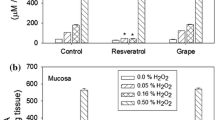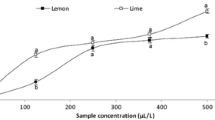Abstract
It is well known that antioxidants present in various fruits, vegetables, and juices have the potential to protect the urinary bladder from free radical damage. What is not well understood, however, is how well antioxidant activities detected by chemical methods such as the CUPRAC assay for total antioxidant activity (TAA) predict the level of physiological protection available. It is hypothesized that the level of antioxidant reactivity found by the CUPRAC assay will positively correlate with increased protection in a model of in vitro ischemia/reperfusion. To test this hypothesis, the CUPRAC assay was utilized to determine the antioxidant reactivity of a series of fruits, vegetables, and juices, and the results were compared to the protective ability of selected juices in an established in vitro rabbit bladder model of ischemia/reperfusion. The results of the CUPRAC test showed that cranberry juice had the highest level of antioxidant reactivity, blueberry juice had an intermediate activity, and orange juice had the lowest. It was determined, however, that contrary to the hypothesis, the orange juice was significantly more potent in protecting the bladder against ischemia/reperfusion damage than either blueberry or cranberry juice. Thus, it is concluded that chemical tests for TAA do not necessarily correlate with their physiological activity.




Similar content being viewed by others
References
Anderson JB, Roerborn CG, Schalken JA, Emberton M et al (2001) The progression of benign prostatic hyperplasia: examining the evidence and determining the risk. Eur Urol 39:390–399
Grayhack JT, Kozlowski JM (1996) Benign prostatic hyperplasia. Adult and pediatric urology, 3rd edn. Mosby Year Book Medical Publishers, Chicago, pp 1501–1574
Barry MJ, Meigs JB (2000) The natural history of benign prostatic hyperplasia. In: Lepor H (ed) Prostatic diseases. Saunders, Philedelphia, pp 106–115
Girman CJ, Guess HA (2000) Epidemiology of benign prostatic hyperplasia. In: Lepor H (ed) Prostatic diseases. Saunders, Philadelphia, pp 116–126
Zderic SA, Levin RM, Wein AJ (1996) Voiding function and dysfunction: a relevant anatomy, physiology, and pharmacology, and molecular biology. In: Gillenwater JY, Grayhack JT, Howards SS, Duckett JD (eds) Adult and pediatric urology, 3rd edn. Mosby Year Book Medical Publishers, Chicago, pp 1159–1219
Levin RM, Chichester P, Hass MA, Gosling JA, Buttyan R et al (2002) Obstructive bladder dysfunction: morphological, biochemical, and molecular changes. Eur Urol Suppl 1:14–20
Greenland JE, Brading AF (2001) The effect of bladder outflow obstruction on detrusor blood flow changes during the voiding cycle in conscious pigs. J Urol 165:245–248
Greenland JE, Hvistendahl JJ, Andersen H et al (2000) The effect of bladder outlet obstruction on tissue oxygen tension and blood flow in the pig bladder. Br J Urol 85(9):1109–1114
Levin RM, O’Connor LJ, Leggett RE et al (2003) Focal hypoxia of the obstructed rabbit bladder wall correlates with intermediate decompensation. Neurourol Urodyn 22:156–163
Kalorin C, Mannikarottu A, Neumann P, Leggett RE, Weisbrot J, Johnson A, Kogan BA, Levin RM et al (2008) Protein oxidation as a novel biomarker of bladder decompensation. Br J Urol 102:495–499
Juan Y, Lin W, Kalorin C et al (2007) The effect of partial bladder outlet obstruction on carbonyl and nitrotyrosine distribution in rabbit bladder. Urology 70:1249–1253
Conners W, Whitebeck C, Chicester P, Anita N et al (2006) (G)-nitro-L-arginine methyl ester (L-name) a nitric oxide synthase inhibitor, diminishes oxidative damage in urinary bladder partial outlet obstruction. Am J Physicol Renal Physiol 290:F357–F363
Resat A, Kubilay G, Birsen D et al (2007) Comparative evaluation of various total antioxidant capacity assays applied to phenolic compounds with the CUPRAC assay. Molecules 12:1496–1547
Agartan CA, Whitbeck C, Sokol R et al (2004) Protection of urinary bladder function by grape suspension. Phytother Res 18:1013–1018
Lin AD-Y, Mannikarottu AS, Chaudhry A et al (2005) Protective effects of grape suspension on in vivo ischemia/reperfusion of the rabbit bladder. BJU 96:1397–1402
Li S, Juan Y-S, Kogan BA et al (2009) Effects of inosine on in vitro hypoxia in the absence of substrate on bladder dysfunction in adult rats. Urology 73:661–664
Lin W-Y, Rehfuss A, Whitbeck C et al (2008) Effect of coenzyme Q10 and α-lipoic acid on the response of the rabbit urinary bladder to repetitive stimulation and in vitro ischemia. Urology 72:214–219
Levin RM, Danek M, Whitbeck C et al (2005) Effect of ethanol on the response of the rat urinary bladder to in vitro ischemia: protective effect of alpha-lipoic acid. Mol Cell Biochem 271:133–138
Brooks JR, Virginia K et al (1986) A modified method for total carbohydrate analysis of glucose syrups, maltodextrins, and other starch hydrolysis products. American Association of Cereal Chemists Inc., vol 63, no. 5
Levin RM, Haugaard N, Levin SS, Buttyan R, Chen MW, Monson FC, Wein AJ (1995) Bladder function in experimental outlet obstruction: pharmacologic responses to alterations in innervation, energetics, calcium mobilization, and genetics. In: Zderic S (ed) Muscle, matrix, and bladder function. Plenum Press, New York, pp 7–19
Valeri A, Ceccarelli I, Fiorenzani P et al (2009) Effects of 17beta-estradiol on rat urinary bladder: gender differences in anoxia-glucopenia and reperfusion damage. Neurourol Urodyn 28:535–541
Pessina F, Solito R, Maestrini D et al (2005) Effect of anoxia-glucopenia and re-superfusion on intrinsic nerves of mammalian detrusor smooth muscle: importance of glucose metabolism. Neurourol Urodyn 24:389–396
Brading A, Pessina F, Esposito L et al (2004) Effects of metabolic stress and ischaemia on the bladder, and the relationship with bladder overactivity. Scand J Urol Nephrol Suppl 215:84–92
Juan YS, Levin RM, Chuang SM et al (2008) The beneficial effect of coenzyme Q10 and alpha lipoic acid on obstructive bladder dysfunction in the rabbit. J Urol 180:2234–2240
Juan Y-S, Hydery T, Mannikarottu A et al (2008) Coenzyme Q10 protect against ischemia/reperfusion induced biochemical and functional changes in rabbit urinary bladder. Mol Cell Biochem 311:73–80
Lin W-Y, Rehfuss A, Schuler C et al (2008) Effect of coenzyme Q10 and α-lipoic acid on the response of the rabbit urinary bladder to repetitive stimulation and in vitro ischemia. Urology 72:214–219
Acknowledgments
This work was supported in part by the Office of Research and Development of the Department of Veterans Affairs and by the Capital Region Medical Research Foundation.
Author information
Authors and Affiliations
Corresponding author
Rights and permissions
About this article
Cite this article
Bean, H., Schuler, C., Leggett, R.E. et al. Antioxidant levels of common fruits, vegetables, and juices versus protective activity against in vitro ischemia/reperfusion. Int Urol Nephrol 42, 409–415 (2010). https://doi.org/10.1007/s11255-009-9639-5
Received:
Accepted:
Published:
Issue Date:
DOI: https://doi.org/10.1007/s11255-009-9639-5




